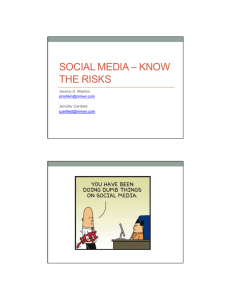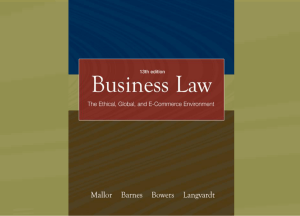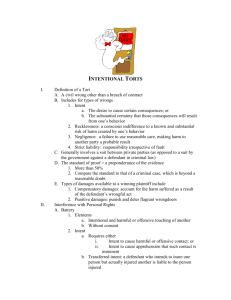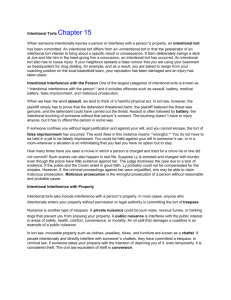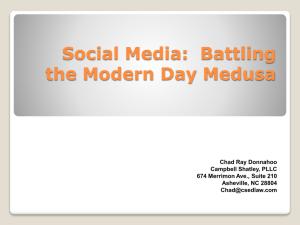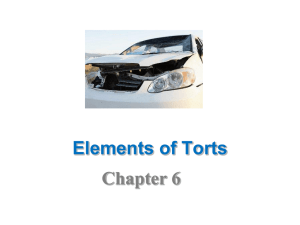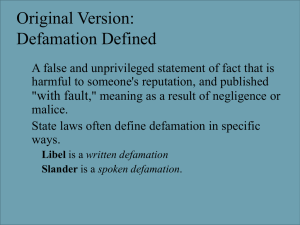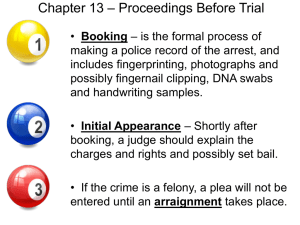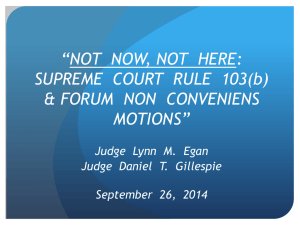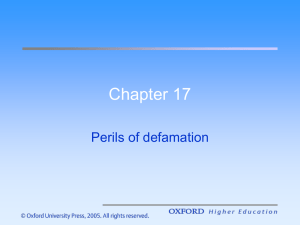Chapter 6
advertisement
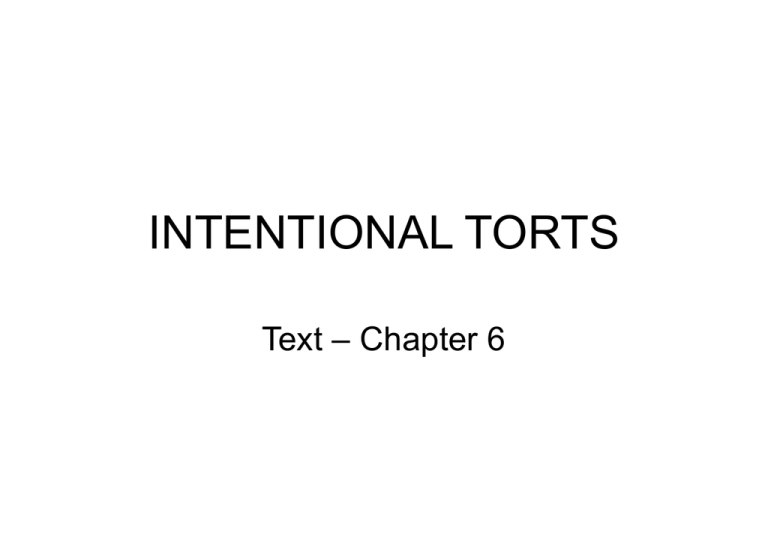
INTENTIONAL TORTS Text – Chapter 6 Learning Objectives • Definition of Tort • Interference with Personal Rights • Interference with Property Rights 6-2 Definition of a Tort • A tort is a civil wrong that is not a breach of a contract • Four types of wrongfulness are involved: 6-3 – Intent – Recklessness – Negligence – Strict liability The Basics • The standard of proof that the plaintiff must satisfy in a tort case is the preponderance of the evidence standard • A plaintiff who wins a tort case usually recovers compensatory damages for the harm suffered as a result of defendant’s wrongful act 6-4 Mathias v. Accor Economy Lodging • Facts & Procedural History: 6-5 – Plaintiffs bitten by bedbugs during hotel stay – Plaintiffs alleged defendant knowingly disregarded evidence of bedbug infestation – Evidence: defendant knew of, ignored problem – Jury awarded plaintiffs compensatory and punitive damages Mathias v. Accor Economy Lodging • Law Applied to Facts: – Defendant’s behavior was outrageous but the compensable harm done was slight and difficult to quantify (primarily emotional) – Award of punitive damages in this case serves purpose of limiting defendant’s ability to profit from its fraud by escaping detection and (private) 6-6 Interference with Personal Rights • Battery • Assault • Intentional Infliction of Emotional Distress • False Imprisonment • Defamation • Invasion of Privacy •6 - 7 Misuse of Legal Proceedings Battery • Intentional and harmful or offensive touching of another without the person’s consent – No liability if person consented • Contact is harmful if it produces bodily injury, but battery includes nonharmful contact that is offensive (reasonable person standard) 6-8 – Example: Wishnatsky v. Huey case Assault • Assault occurs when there is an intentional attempt or threat to cause a harmful or offensive contact with another person, if the attempt causes a reasonable apprehension of imminent battery in the other person’s mind • Irrelevant whether threatened contact 6 - 9 really occurs, as long as plaintiff had Intentional Infliction of Emotional Distress • Most courts allow recovery for emotional distress even if no other tort is proven • All courts require the wrongdoer’s conduct to be outrageous before liability is imposed • Most courts apply reasonable person test 6 - 10 False Imprisonment • False imprisonment is intentional confinement of another for an appreciable time without his consent – confinement must be complete, though a few minutes is enough – no liability if plaintiff consented to confinement • Example: Banks v. Fritsch 6 - 11 – Defendant’s conduct must be intentional or reckless and outrageous, and plaintiff must have suffered serious mental injury Defamation • Defamation is an – – – – (1) unprivileged (2) publication of (3) false and defamatory (4) statements concerning another person • Libel refers to written defamation and slander refers to oral defamation • Truth is a complete defense in a defamation case 6 - 12 Defamation • Another defense to defamation is privilege 6 - 13 – Examples: statements made by participants in judicial proceedings, by officials in the course of their duties, by one spouse to the other in private, and fair and accurate media reports (fair comment) of defamatory matter that appears in proceedings of official government action or originates from public meetings Defamation & Free Speech • In New York Times Co. v. Sullivan (1964), the U.S. Supreme Court held that when a public official brings a defamation case, s/he must prove the usual elements of defamation and actual malice (a First Amendment–based fault requirement) – Actual malice means knowledge of falsity or reckless disregard for the truth – (See Hearst Corp. v. Skeen) • The holding of this case has been extended 6 - 14 Invasion of Privacy • Invasion of privacy refers to four distinct torts: – Intrusion on Solitude or Seclusion • Applies only with a reasonable expectation of privacy – Public Disclosure of Private Facts – False Light Publicity – Commercial Appropriation of Name or Likeness 6 - 15 • Example: Comedy III Productions, Inc. v. Comedy III Productions v. Saderup • Facts & Procedural History: – In California, the right of publicity is inheritable – Comedy III Productions, Inc. owns rights of publicity to the deceased celebrities familiar to the public as “The Three Stooges” – Without Comedy III’s consent, defendants produced and profited from sale of lithographs and T-shirts bearing a likeness of The Three Stooges – Comedy III brought a right of publicity action 6 - 16 Comedy III Productions v. Saderup • Issue: – Did defendants violate a right of publicity? • Legal Reasoning and Holding: 6 - 17 – Saderup argues that his portraits of The Three Stooges are expressive, transformative works and must receive full First Amendment protection – No significant transformative or creative contribution exists in Saderup’s work – If Saderup wishes to continue to depict The Three Stooges as he has done, he may do so Misuse of Legal Proceedings • Three intentional torts protect people against the harm that can result from wrongfully instituted legal proceedings: 6 - 18 – Malicious prosecution: wrongful institution of criminal proceedings – Wrongful use of civil proceedings: wrongfully instituted civil suits – Abuse of process: imposes liability on those who initiate legal proceedings, whether criminal or civil, for a primary purpose other than the one for which the proceedings were Deceit (Fraud) • Deceit (or fraud) is the formal name for the tort claim that is available to victims of knowing or intentional misrepresentations 6 - 19 – Often connected to a breach of contract claim – Requires proof of false statement of material fact, knowingly or recklessly made by defendant with intent to induce reliance by the plaintiff, along with actual, Interference with Property Rights • Trespass to Land • Private Nuisance • Conversion 6 - 20 Trespass to Land • Any unauthorized or unprivileged intentional intrusion upon another’s real property, including physically entering the plaintiff’s land, causing another person or object to do so, remaining on the land after one’s right to remain has ceased, and invading airspace above land or subsurface below • Intent required for liability is simply the 6 - 21 intent to be on the land, so a person may Private Nuisance • Involves some interference with plaintiff ’s use and enjoyment of the land • Unlike trespass to land, nuisance does not require a physical invasion of the property – May include odors, noise, smoke, light, vibration • Liability requires the interference to be 6 - 22 Conversion • Defendant’s intentional exercise of dominion or control over plaintiff’s personal property without plaintiff’s consent through: 6 - 23 – Acquisition – Removal – Transfer to another – Withholding possession – Destruction or alteration
